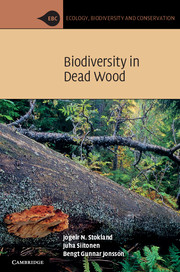Book contents
- Frontmatter
- Contents
- Preface
- 1 Introduction
- 2 Wood decomposition
- 3 The saproxylic food web
- 4 Other associations with dead woody material
- 5 Host-tree associations
- 6 Mortality factors and decay succession
- 7 Microhabitats
- 8 Tree size
- 9 The surrounding environment
- 10 Evolution of saproxylic organisms
- 11 Species diversity of saproxylic organisms
- 12 Natural forest dynamics
- 13 Dead wood and sustainable forest management
- 14 Population dynamics and evolutionary strategies
- 15 Threatened saproxylic species
- 16 Dead wood in agricultural and urban habitats
- 17 The value and future of saproxylic diversity
- References
- Index
Preface
Published online by Cambridge University Press: 05 June 2012
- Frontmatter
- Contents
- Preface
- 1 Introduction
- 2 Wood decomposition
- 3 The saproxylic food web
- 4 Other associations with dead woody material
- 5 Host-tree associations
- 6 Mortality factors and decay succession
- 7 Microhabitats
- 8 Tree size
- 9 The surrounding environment
- 10 Evolution of saproxylic organisms
- 11 Species diversity of saproxylic organisms
- 12 Natural forest dynamics
- 13 Dead wood and sustainable forest management
- 14 Population dynamics and evolutionary strategies
- 15 Threatened saproxylic species
- 16 Dead wood in agricultural and urban habitats
- 17 The value and future of saproxylic diversity
- References
- Index
Summary
Preface
The last few decades have witnessed a rapidly increasing interest in the importance of dead and decaying trees for biodiversity. During their decomposition, dead trees offer habitats for thousands of species. This diversity has been studied by researchers interested in particular organism groups, such as cavity-nesting birds, wood-decaying fungi or saproxylic invertebrates. A holistic overview of the species communities inhabiting trees after their death has been lacking, and our aim is to provide such an overview here.
The scope of the book is global, but we admit that it has a strong north European bias. There are two reasons for this. Firstly, much of the research and many of the scientific publications about species living in dead wood originate from northern Europe, although during the last decade an increasing number of papers dealing with saproxylic organisms have also been published in North America, Australia, Japan and elsewhere. Secondly, our own studies have taken place in Fennoscandia, and our empirical knowledge is mainly derived from the boreal and temperate parts of Europe. We admit that we only have superficial first-hand experience of tropical forests and the temperate and evergreen forests of other continents.
- Type
- Chapter
- Information
- Biodiversity in Dead Wood , pp. xiii - xivPublisher: Cambridge University PressPrint publication year: 2012



